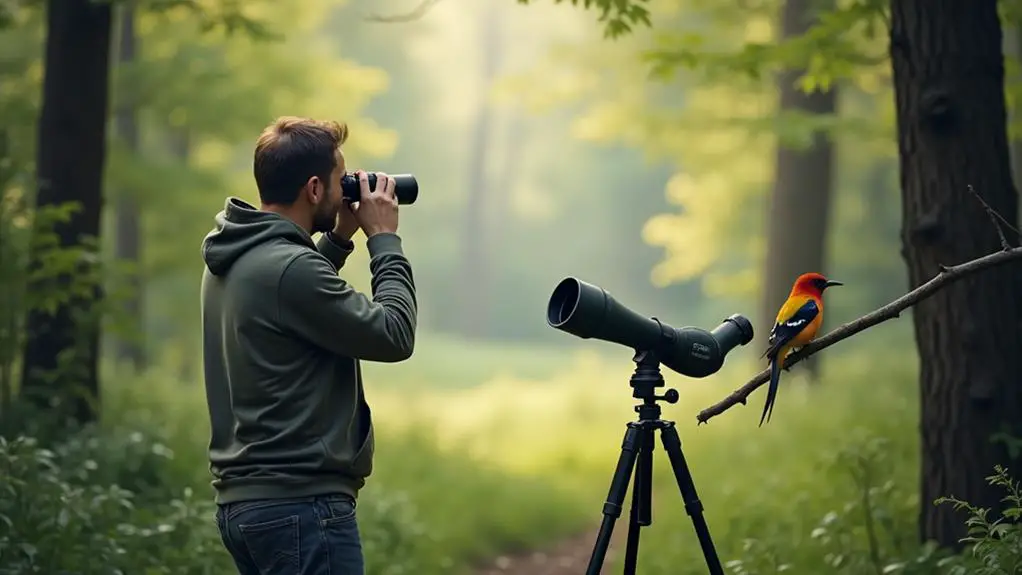You've likely heard that spotting scopes are ideal for birdwatching, but is that really true? Or are binoculars the better choice? The answer lies in understanding their unique strengths and weaknesses. Both optics have their fans, but which one will give you the best bird's-eye view? If you're looking for extreme magnification power and a broader view of your feathered friend, a spotting scope might be the way to go. But if you need to track birds on the move or scan the skies for that elusive species, binoculars could be your new best friend. The question is, what's the right tool for your birdwatching adventure?
Key Takeaways
- Magnification power: Spotting scopes offer higher magnification, but binoculars provide zoom flexibility for varying distances and light conditions.
- Field of view: Binoculars offer a wider angle viewing experience, while spotting scopes sacrifice field of view for higher magnification power.
- Portability: Binoculars are generally lighter and more compact, making them ideal for long-distance carrying, while spotting scopes are bulkier.
- Image quality: Spotting scopes excel in low-light conditions and offer longer eye relief, while binoculars provide better close-focus capabilities.
- Cost: Binoculars are generally more affordable, with entry-level options under $100, while spotting scopes have a higher price point, especially with tripod costs.
Understanding Magnification Power
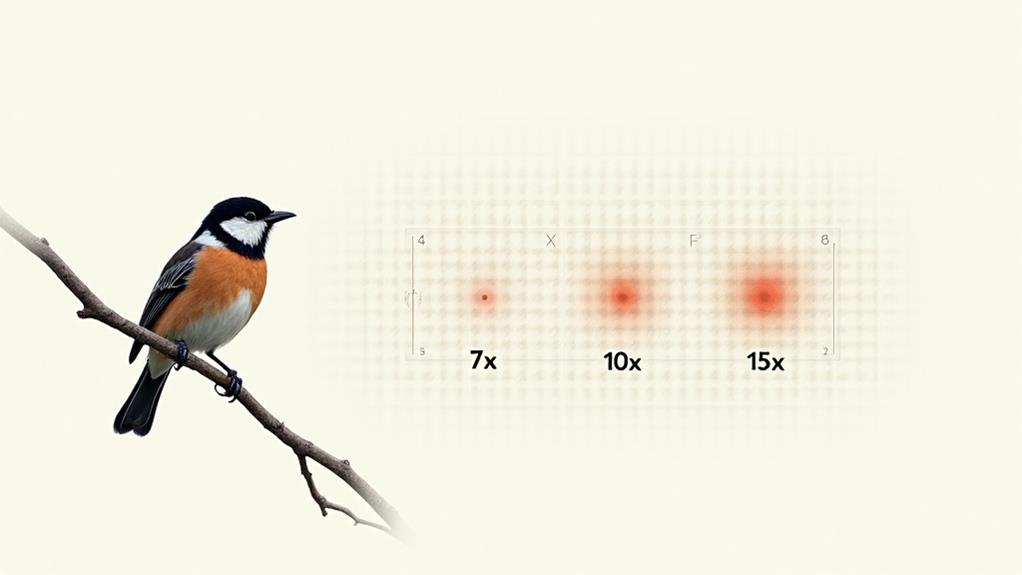
When you're considering a spotting scope or binoculars for your outdoor activities, understanding magnification power is crucial to make an informed decision.
Magnification power refers to the ability of the optic to enlarge an image, allowing you to see details that would be impossible with the naked eye.
However, it's essential to recognize that magnification power has its limits.
Exceeding magnification limits can result in a distorted, blurry image, making it difficult to distinguish details.
For instance, a spotting scope with a high magnification power may not provide a clear image in low-light conditions or when the target is moving.
On the other hand, binoculars often offer zoom flexibility, allowing you to adjust the magnification power according to your needs.
This flexibility is particularly useful when observing objects at varying distances.
Field of View Comparison
When you're choosing between a spotting scope and binoculars, you'll want to consider the field of view, as it affects your ability to observe targets.
You'll find that binoculars typically offer a wider angle viewing experience, making it easier to track moving subjects or scan a broader area. In contrast, spotting scopes are designed for magnified observation, often sacrificing field of view for higher magnification power.
Wide Angle Viewing
Your eyes scan the horizon, taking in the vast expanse of the landscape as you search for your target.
When it comes to wide angle viewing, both spotting scopes and binoculars have their strengths and weaknesses.
Spotting scopes typically offer a wider field of view, often ranging from 100-150 feet at 1,000 yards. This allows you to take in wide vistas and enjoy an immersive experience, perfect for scanning vast open spaces or tracking birds in flight.
Binoculars, on the other hand, typically have a narrower field of view, usually around 300-350 feet at 1,000 yards. While this may seem limiting, it can actually be beneficial for focusing on a specific area or target, allowing for a more detailed observation.
When considering wide angle viewing, it's essential to think about your specific birdwatching needs and preferences. Do you prioritize sweeping views or precise focus?
Magnified Observation
As you shift your attention from wide angle viewing to magnified observation, the field of view comparison between spotting scopes and binoculars takes on a new significance.
When you're trying to observe birds up close, magnified clarity becomes crucial.
In this realm, spotting scopes outperform binoculars in several ways:
- Wider magnification range: Spotting scopes typically offer higher magnification powers (up to 60x or more) compared to binoculars (usually up to 12x).
- Larger objective lenses: Spotting scopes have larger objective lenses, allowing more light to enter and resulting in a brighter, more detailed image.
- Better close inspection: With a spotting scope, you can get a closer look at your subject without physically moving closer, which is especially useful for birdwatching.
- More precise focus: Spotting scopes often feature more precise focus controls, ensuring a sharper image even at high magnifications.
Portability and Weight
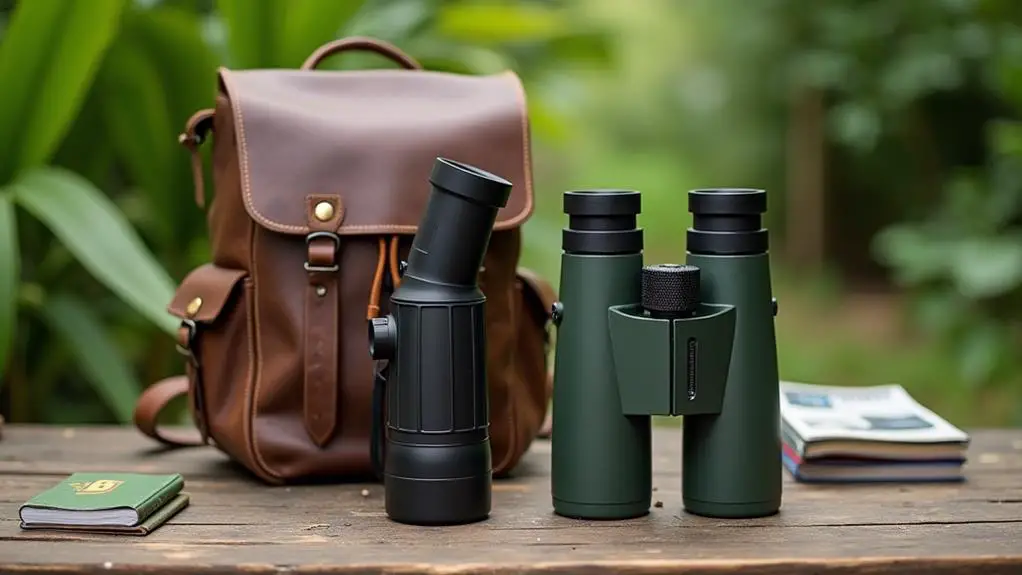
Between spotting scopes and binoculars, a significant difference lies in their portability and weight.
When you're planning a birdwatching trip, packing priorities come into play, and every ounce counts. Travel constraints, such as limited backpack space or long hikes, can dictate which optic you choose.
Spotting scopes, typically longer and heavier, can be cumbersome to carry, especially if you're planning to cover long distances. A high-quality spotting scope can weigh anywhere from 2-5 pounds, making it a significant addition to your pack.
In contrast, binoculars are generally lighter and more compact, with most models weighing between 1-2 pounds. This significant weight difference can be a deciding factor for birdwatchers who need to travel light.
When considering portability and weight, you'll want to think about your specific needs and how they'll impact your birdwatching experience. Will you be stationary or on the move? How much weight are you willing to carry? Your answers to these questions will help you choose the best optic for your needs.
Image Stabilization Features
When you're choosing between spotting scopes and binoculars, you'll want to consider the image stabilization features that help reduce handshake and motion blur.
You'll likely come across three main types: Optical Image Stabilizer, Electronic Stabilization Systems, and Gyroscopic Stabilization Technology.
Each of these technologies works differently to provide a clearer, more stable image, and understanding their differences is key to making an informed decision.
Optical Image Stabilizer
You're likely familiar with the frustration of trying to get a clear view through your optics while dealing with shaky hands or a moving platform.
This is where optical image stabilizers come into play. These innovative systems use carefully designed lens elements and prism arrangements to counteract the movements, providing a stable and clear view.
Optical image stabilizers are particularly useful for handheld versatility, allowing you to observe birds in their natural habitat without the need for a tripod.
- Reduced fatigue: You can hold your optics for longer periods without straining your hands or arms.
- Improved optical clarity: The stabilized image provides a sharper and more detailed view of your subject.
- Enhanced portability: Optical image stabilizers make your optics more convenient to carry and use in the field.
- Better low-light performance: By reducing camera shake and motion blur, optical image stabilizers enable you to observe birds in low-light conditions.
When choosing between spotting scopes and binoculars, consider the importance of optical image stabilization for your birdwatching needs.
Electronic Stabilization Systems
Beyond optical image stabilizers, electronic stabilization systems offer an alternative approach to image stabilization.
These systems use electronic sensors and motors to detect and counteract hand movement, providing a smoother viewing experience. You'll often find electronic stabilization systems in high-end spotting scopes and binoculars designed for birdwatching.
When you use a spotting scope or binoculars with an electronic stabilization system, you'll notice that the image remains steady even when your hands are shaking.
This is because the system's sensors detect the movement and send a signal to the motor, which then adjusts the optical elements to compensate. This results in a clearer, more stable image.
Some electronic stabilization systems also incorporate Active Damping, which reduces the oscillations caused by hand movement.
Additionally, Electronic Counterweights can be used to balance the weight of the optical instrument, making it easier to hold steady.
Gyroscopic Stabilization Technology
Precision takes center stage with gyroscopic stabilization technology, a cutting-edge innovation that redefines the boundaries of image stabilization.
As you delve into the world of birdwatching, you'll appreciate the significance of this technology in capturing crisp, clear images even in the most dynamic environments.
With gyroscopic stabilization, you can say goodbye to blurry images and hello to:
- Motion tracking: Effortlessly follow your feathered friends as they flit from branch to branch, without worrying about camera shake or blur.
- Smooth footage: Enjoy seamless video recording, even when panning or zooming, thanks to the advanced gyroscopes that compensate for hand movement.
- Reduced fatigue: Spend more time observing and less time adjusting your spotting scope or binoculars, as the gyroscopic system takes care of image stabilization for you.
- Enhanced detail: Capture intricate details of your avian subjects, from the subtlest feather patterns to the brightest plumage colors, with unparalleled clarity.
Eye Relief and Comfort

Your observing experience hinges on the ergonomic harmony between your eyes and the optical instrument.
When it comes to spotting scopes and binoculars, eye relief and comfort play a critical role in reducing eye strain and visual fatigue. Eye relief, measured in millimeters, refers to the distance between the lens and your eye.
A longer eye relief allows you to observe comfortably, even with eyeglasses or sunglasses. Spotting scopes typically offer longer eye relief, often between 15-20mm, making them suitable for extended observation sessions.
Binoculars, on the other hand, usually have shorter eye relief, ranging from 10-15mm. This can lead to eye strain and discomfort, especially during prolonged use.
You'll want to consider your personal comfort level and observing style when choosing between the two. Look for instruments with adjustable eye cups or rubber eyecups to ensure a comfortable fit and minimize visual fatigue.
Objective Lens Size Matters
As you settle into a comfortable observing position, your attention turns to the quality of the image itself.
When it comes to spotting scopes and binoculars, the objective lens size plays a critical role in determining the quality of the image. A larger objective lens allows more light to enter, resulting in a brighter and sharper image. This is especially important for birdwatching, where you often observe subjects at a distance.
- Improved low-light performance: A larger objective lens allows you to observe birds in low-light conditions, such as early morning or late evening.
- Increased resolution: A larger objective lens provides a higher resolution, making it easier to distinguish subtle details on your bird subjects.
- Better color reproduction: A larger objective lens enables better color reproduction, resulting in more vibrant and accurate colors.
- Enhanced contrast: A larger objective lens enhances contrast, making it easier to distinguish between different bird species.
When evaluating spotting scopes and binoculars, look for objective lens sizes that meet your specific needs.
Keep in mind that a larger objective lens often requires a larger and heavier device, which may impact portability.
However, the improved lens quality and optical design can make a significant difference in your birdwatching experience.
Budget and Cost Considerations
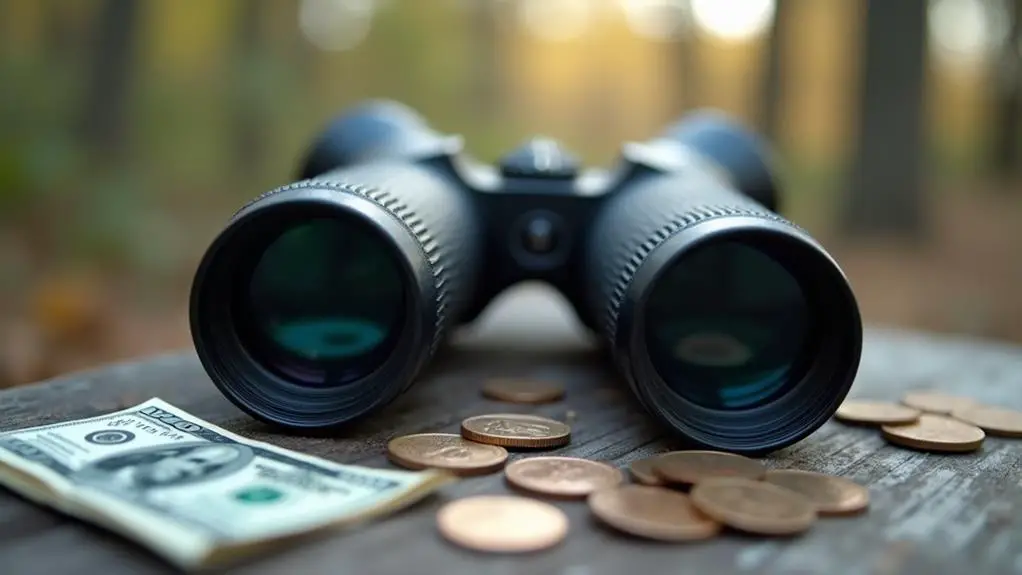
Budget constraints play a significant role in the decision-making process when choosing between spotting scopes and binoculars.
As you weigh your options, it's essential to consider the price points of each. Spotting scopes generally have a higher price point than binoculars, especially when you factor in the cost of a tripod. However, you may find that the investment is worth it for the increased magnification and image quality.
Binoculars, on the other hand, can be more affordable, with entry-level options available for under $100.
Mid-range binoculars with good optical quality can cost between $200-$500. High-end models with advanced features can range from $1,000 to $2,000 or more.
Spotting scopes typically start at around $200-$300 for a basic model and can go up to $1,500 or more for high-end models with advanced features.
When setting your budget, consider your birdwatching needs and the features that matter most to you.
If you're a casual birder, entry-level binoculars might suffice. But if you're serious about getting up close and personal with your feathered friends, a spotting scope might be worth the investment.
Close-Focus Capabilities
Spotting scopes and binoculars differ significantly in their close-focus capabilities, which can greatly impact your birdwatching experience.
When observing birds at close distances, you'll want a device that can focus on your subject without compromising image quality.
The focus limits of spotting scopes and binoculars vary greatly. Generally, spotting scopes can focus on objects as close as 10-15 feet, while binoculars have a much closer focus limit, often ranging from 5-10 feet.
This means that if you're trying to observe birds in a dense thicket or a nearby feeder, binoculars might be the better choice.
Here are some key differences to consider:
- Spotting scopes: Typically have a longer minimum focus distance, making them better suited for observing birds at a distance.
- Binoculars: Can focus on objects much closer, making them ideal for observing birds in tight spaces.
- Close distances: Binoculars often excel in situations where you need to observe birds at close range.
- Focus limits: Be sure to check the focus limits of your device to ensure it can handle the distances you need.
Tripod and Mounting Options
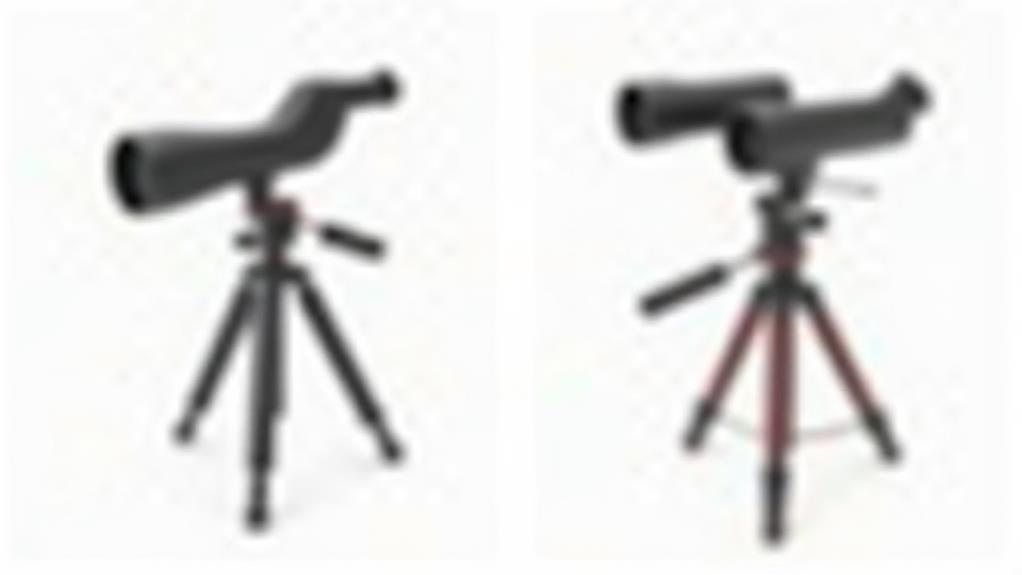
Set up for success by considering the tripod and mounting options of your spotting scope or binoculars, as a sturdy base can make all the difference in your birdwatching experience. When choosing a tripod, look for adjustable height options to ensure a comfortable viewing experience, regardless of your standing or sitting position. A quick release mounting system is also essential, allowing you to quickly attach and detach your optics from the tripod.
| Feature | Spotting Scope | Binoculars |
|---|---|---|
| Tripod compatibility | Typically requires a tripod adapter | Often has a built-in tripod adapter |
| Mounting system | Usually features a quick release plate | May have a fixed or quick release mounting system |
| Adjustability | Often has adjustable height and pan/tilt head | May have limited adjustability |
When it comes to mounting options, consider the type of attachment system your optics require. Some spotting scopes may need a tripod adapter, while binoculars often have a built-in adapter. Ensure the mounting system is quick release, allowing you to easily switch between tripod and handheld use. By selecting the right tripod and mounting options, you'll be well on your way to a successful birdwatching experience.
Frequently Asked Questions
Can I Use a Spotting Scope for Observing Birds in Low Light Conditions?
You'll find that a spotting scope's low light performance is generally better than binoculars, but it still depends on the model's objective lens size and quality. Look for image stabilization to reduce handshake blur in low light conditions.
Are There Spotting Scopes With Built-In Cameras for Capturing Images?
You'll find spotting scopes with built-in cameras, but be aware that camera quality and image resolution may vary, impacting the clarity of your captured bird images; research models with high megapixel counts and 4K video capabilities for optimal results.
How Do I Choose Between Angled and Straight Spotting Scopes for Birdwatching?
When selecting a spotting scope for birdwatching, you'll choose between angled and straight models; consider eye relief, ensuring a comfortable viewing distance, and field curvature, which affects image distortion, to determine the best fit for your observing style.
Can I Use Birdwatching Binoculars for Observing Other Wildlife Like Deer?
You can use your birdwatching binoculars for observing deer, as they're suitable for wildlife observation. However, you'll need to consider deer behavior, such as their larger size and increased movement, requiring a wider field of view and potentially more magnification.
Are There Any Birdwatching Spotting Scopes Suitable for Children or Beginners?
As you hold the torch of curiosity, igniting a love for birdwatching in the next generation, you'll find kid-friendly spotting scopes with youthful optics, featuring adjustable eyecups, compact designs, and easy-to-use focus knobs, perfect for little hands to grasp and explore.
Conclusion
Now that you've weighed the pros and cons of spotting scopes and binoculars, remember: "the right tool for the job" is key to a successful birdwatching experience. If you're after detailed observations of stationary subjects, a spotting scope's high magnification power and wider field of view might be the way to go. But if you need to track moving subjects or scan broader areas, binoculars' zoom flexibility and portability make them the better choice. Choose wisely, and you'll be flying high in no time!

